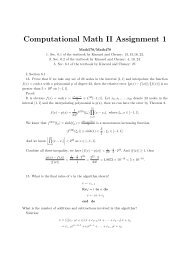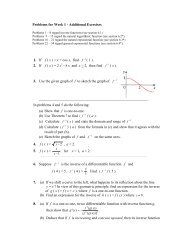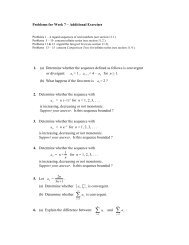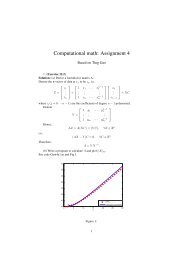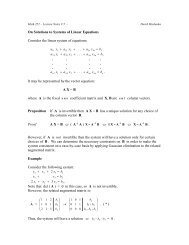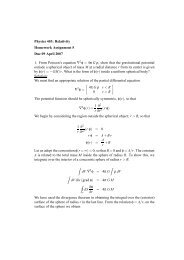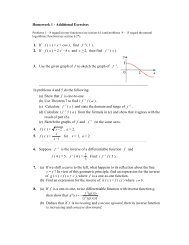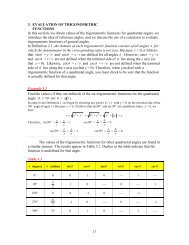Physics 123 Quizes and Examinations Spring 2007 Porter Johnson ...
Physics 123 Quizes and Examinations Spring 2007 Porter Johnson ...
Physics 123 Quizes and Examinations Spring 2007 Porter Johnson ...
You also want an ePaper? Increase the reach of your titles
YUMPU automatically turns print PDFs into web optimized ePapers that Google loves.
<strong>Physics</strong> <strong>123</strong><strong>Quizes</strong> <strong>and</strong> <strong>Examinations</strong><strong>Spring</strong> <strong>2007</strong><strong>Porter</strong> <strong>Johnson</strong>“<strong>Physics</strong> can only be learned by thinking, writing, <strong>and</strong> worrying.”-David Atkinson <strong>and</strong> <strong>Porter</strong> <strong>Johnson</strong> (2002)“There is no royal road to geometry.”-Euclid
That is,T = 2v 0g = 2 × 4 = 0.8 sec10How long can a person stay in the air? Why is it that many non-flyingcreatures can remain aloft for about the same amount of time?3. PHYS <strong>123</strong> - 051 QUIZ 2 13 February <strong>2007</strong>The following two vectors are given:⃗A⃗B= 2î+2 ĵ+ ˆk= î − 2 ĵ+ 2ˆk• Determine the scalar product ⃗A ·⃗B.• Determine the vector product ⃗A ×⃗B.• Determine the angle between the vectors ⃗A <strong>and</strong> ⃗B.Solution:The scalar product is expressed in terms of components as⃗A ·⃗B = A x B x + A y B y + A z B z = (2)(1)+(2)(−2)+(1)(2) = 0Since the scalar product vanishes, the angle between the vectors is 90 o .The vector product is⃗A ×⃗B =∣î ĵ ˆk2 2 11 −2 2⎤⎦ = 6î − 3 ĵ − 6ˆkAs a consistency check, note that |⃗A| = 3, |⃗B| = 3, <strong>and</strong> |⃗A ×⃗B| = 9, so that|⃗A ×⃗B| = |A||B|sinθ9 = (3)(3)sinθsinθ = 1θ = 90 o
4. PHYS <strong>123</strong> - 052 QUIZ 2 15 February <strong>2007</strong>A long jumper leaves (level) ground at a speed of v 0 = 10 meters per second.• What is the maximum distance D that the jumper will travel beforereturning to the ground?• Under those conditions, determine the time of flight T <strong>and</strong> the maximumheight H reached by the jumper.Note: you may treat the jumper as a “point mass”, <strong>and</strong> take g = 10m/s 2 .Solution:Let the launch angle by θ. The horizontal <strong>and</strong> vertical components of velocityare, respectively,v 0xv 0y= v 0 cosθ= v 0 sinθIf the jumper takes off at time t = 0 from positions x = 0 <strong>and</strong> y = 0, thepositions at time t arexy= v 0 cosθt= v 0 sinθt − 1 2 gt2The time T at which the jumper returns to the ground is obtained by settingy(T) = 0, so thatv 0 sinθT = 1 2 gT 22v 0 sinθgThe distance traveled, D, is given by= TD = v 0x T = v2 0g (2sinθ cosθ) = v2 0g sin2θ
The distance D depends upon the launch angle θ. The greatest distance isobtained by settingThe maximum distance isThe maximum height reached issin2θ = 12θ = 90 oθ = 45 oD = v2 0g = 10210 = 10 mH = 1 2 g(T/2)2 = 1 2 g(v 0 sinθ) 2 = 1 v 2 0g 4 g = 2.5 mBoth these numbers exceed the world record for high jump (H = 2.45 m) aswell as long jump (D = 8.95 m).5. PHYS <strong>123</strong> - 051 QUIZ 3 27 February <strong>2007</strong>A lamp hangs vertically down from a light cord attached to the ceiling of anelevator.• When the elevator is descending, <strong>and</strong> decelerating at 3 m/s2, there is atension of 80 N in the cord. What is the mass of the lamp?• While still descending, the elevator begins to accelerate at 3 m/s2.What is the tension in the cord in that case?Solution:Take the positive direction to be downward. The acceleration of the elevatoris a = −3m/sec 2 . If m is the mass of the lamp, the net force acting on itis F = ma. The two forces on the lamp are its weight W = mg (downward)<strong>and</strong> the tension T = −80 N (upward). Thus
mg − T= mam(g − a) = 80m(10 −(−3)) = 80m = 80 = 6.2 kg13For the second part of the problem, a ′ = +3 m/s 2 , so thatmg − T ′ = ma ′m(g − a ′ ) = T ′T ′6. PHYS <strong>123</strong> - 052 Quiz 3 01 March <strong>2007</strong>= m(10 − 3) = 6.2(7) = 43 NAn old streetcar rounds a flat corner of radius 10 meters at a speed of 8 meters/second.What angle with the vertical will be made by the h<strong>and</strong> straps,which hang loosely?Solution:For simplicity we assume that the straps consist of a massless string, with amass m at its bottom. The forces acting on the mass are its weight W = mg(downward) <strong>and</strong> the tension in the string T , acting along the string at anangle θ to the vertical. The net vertical component of force on the massmust vanish, whereas the net horizontal force on it must be equal to its massmultiplied by the centripetal acceleration. ThusTaking the ratio, we obtainmgmv 2R= T cosθ= T sinθtanθ = v2Rg = 8210 · 10 = 0.64The angle is θ = 32 o . This is a rather sharp turn!
7. PHYS <strong>123</strong> - 051 Quiz 4 20 March <strong>2007</strong>A fully loaded, slow-moving, freight elevator cab has a total mass of m 1 =1500 kg. It is must move upward by h = 60 meters in ∆t = 2.0 minutes,starting <strong>and</strong> ending at rest. The mass of the elevator counterweight is onlym 2 = 1000 kg, so that the elevator motor must help in the ascent.What average power P (in Watts) is required of the force that the motorexerts on the cab by means of the cable?Solution:The change (an increase) in the gravitational potential of the energy of theelevator cab is∆E 1 = m 1 g h = 1500 · 10 · 60 = 9 × 10 5 JThe change (a decrease) in gravitational potential energy of the counterweightis∆E 2 = −m 2 g h = −1000 · 10 · 60 = −6 × 10 5 JThe net change in gravitational potential energy is∆E = ∆E 1 − ∆E 2 = 3 × 10 5 JThe energy must be provided by the elevator motor, over a period ∆t = 120seconds. Thus, the power provided by the motor isP = ∆E∆t= 3 × 105 J120 sec = 2.5 × 103 W = 2.5 kWSince one horsepower is approximately 750 Watts, the motor must provideenergy at the rate of about 3.3 HP.Elevators are rated according to the “maximum load” that they can carry,according to the maximum power that can be provided by the driving motorat a certain speed. Roughly speaking, the mass of the counterweight shouldmatch the mass of the elevator plus its “average” load.
8. PHYS <strong>123</strong> - 052 Quiz 4 22 March <strong>2007</strong>You push an m = 5.0 kg block against a light horizontal spring, compressingthat spring against a wall by x = 20 cm. Then you release the block, <strong>and</strong> thespring sends it across a tabletop. It stops at d = 80 cm from where youreleased it. The spring constant is 300 N/m.What is the coefficient of kinetic friction µ k between the block <strong>and</strong> the table?Solution:All of the potential energy stored in the spring is given to the block duringthe release:E = 1 2 k x2 =300 ×(0.2)22= 6 JThis energy is all dissipated as the block slides across the floor. When akinetic friction force f k acts over a distance d, the dissipated energy is f k d,so thatf k d = Ef k (0.8) = 6f k= 7.5 NThe normal force of the block on the bable is equal in magnitude to itsweight; N = mg = 5 · 10 = 50 N. Thus, the coefficient of kinetic friction isµ k = f kN = 7.550 = 0.159. PHYS <strong>123</strong> - 051 QUIZ 5 03 April <strong>2007</strong>An object of mass m = 3 kg is initially moving with a speed of v 0 = 8 metersper second in the +x-direction. It has an elastic collision with an object ofmass M, which is initially at rest. After the collision the object of mass Mhas a speed of V = 6 meters per second, also in the +x-direction.• Determine the mass M.
Solution:The momentum (horizontal) <strong>and</strong> energy are both conserved, so thatWe solve the first equation for v:mv 0 = mv+MV12 mv2 0 = 1 2 mv2 + 1 2 MV 2v = v 0 − M m VWe substitute this into the second equation to obtainv 2 0 =(v 0 − M m V ) 2+ M m V 2Thus, M = 5 kg.Mm (2V v 0 −V 2 ) =Mm( Mm) 2V 2= 2v 0 −VV10. PHYS <strong>123</strong> - 052 QUIZ 5 05 April <strong>2007</strong>= 2 · 8 − 66= 5 3An M = 4000 kg block falls vertically through h = 12 meters, <strong>and</strong> thencollides with a a m = 500 kg pile, driving it x = 20 cm into solid ground,before the block comes to rest on top of the pile.Determine the average force F on the pile by the solid ground. during itscollision with the block.Note: consider the collision between the block <strong>and</strong> the pile to be completelyinelastic.Solution:The speed of the block before the collision with the pile is given by equatingits initial gravitational potential energy to its kinetic energy just before thecollision:
12 MV 2 = MghV= √ 2gh = √ 2 · 10 · 40 = √ 240 = 15.5 m/secDuring the completely inelastic collision between the block <strong>and</strong> the pile, themomentum is conserved:(M + m)V ′ = MVV ′ M=M + m V = 400 15.5 = 13.8 m/sec450The kinetic energy after the collision equals the work done against frictionF x = 1 ′2(M + m) V2F(0.2) = 1 2 (450)(13.8)2 = 4.0 × 10 5 JF= 2.0 × 10 6 N11. PHYS <strong>123</strong> - 051 QUIZ 6 17 April <strong>2007</strong>A thin uniform rod of length l = 2 meters <strong>and</strong> mass m = 0.1 kg is pivotedabout a horizontal, frictionless pin put through one end. It is released at anangle θ = 60 o above the horizontal. Use energy conservation to determinethe speed v of the moving end of the rod as it passes through the horizontalposition.Solution:The initial potential energy of the rod is m g h, where h = lsinθ/2 is theheight of its center of mass above the pivoted end. As it swings through thehorizontal position, its kinetic energy is K = 1/2I ω 2 , where ω is its angularvelocity at that instant, <strong>and</strong> L is the moment of inertia of the rod about itspivot point. We divide the rod into infinitesimal slices of thickness dx <strong>and</strong>mass dm = m dx/l. The moment of inertia of the rod about its end is
ZI =x 2 dm =Z l0x 2 m dxl= m lZ l0x 2 dx = m ll 33 = ml23Because of conservation of energy we obtainThus12 mglsin60o = 1 2 I ω2 = 1 213 m l2 ω 2ω 2 = 3√ 3 g= 2.6 × 5 = 132 lω = 3.6 rad/secThe speed at the moving end is v = ω l = 7.2 m/s.12. PHYS <strong>123</strong> - 052 QUIZ 6 19 April <strong>2007</strong>A bowler throws a bowling ball of radius R = 10 cm along a horizontal laneat an initial speed v 0 = 8 m/s. The ball slides along the lane with initialangular velocity ω 0 = 0. The coefficient of kinetic friction between the ball<strong>and</strong> the lane is µ k = 0.2 This kinetic friction force produces a torque on theball, resulting in an angular acceleration of the ball. When the linear speedv <strong>and</strong> angular velocity ω satisfy v = ω R, the ball begins rolling withoutslipping.Note: The moment of inertia of the ball about its center is I = 2m R 2 /5.What is the linear speed v of the ball when it begins to roll without slipping?How far (D) does the ball travel before it begins to roll without slipping?Solution:There are three forces: the weight mg downward, the normal force N =mg upward, the friction force f k = µ k mg (left), opposite the direction ofmotion. The net force is equal to the friction force. Thus, the component ofacceleration in the direction of motion is a = −µ k g. The friction force alsoproduces a (clockwise) torque about the center of the ball: τ = f k R. Thus,
there is an angular acceleration α = τ/I = 5 f k /2 mR 2 . The velocity v <strong>and</strong>angular velocity ω at time t arevω= v 0 − µ k gt= αt = 5µ k mg t R2 mR 2We set v = ωR to determine the time at which slippage stops:The velocity at this time isThe distance traveled isv 0 − µ k g t = 5µ k g t2RR[v 0 = µ k g − 5µ kg2[8 = 0.2 · 10 −t= 1.14 sec]t5 · 0.2 · 102v = v 0 − 2 · 1.14 = 5.7 m/sd = v 0 + v2t = 13.7 1.14 = 7.8 m2]t = 7tAfter this point, the ball begins to roll without slipping. Typically, a bowlingball “hooks” at this point, because of the initial spin given to it by thebowler. For the best shots a right-h<strong>and</strong>ed player should hit the 1 − 3 pocket,to compensate for this spin.13. PHYS <strong>123</strong> - 051 QUIZ 7 24 April <strong>2007</strong>A uniform ladder of length L = 10 meters has a mass m = 40 kilograms.It is leaned against a frictionless vertical wall at an angle θ to the vertical,while being supported at its base on a horizontal surface. The coefficient ofstatic friction between the ladder <strong>and</strong> the horizontal surface is µ s = 0.15.
Determine the maximum tilt angle θ at which the ladder can be in staticequilibrium.Solution:The force F produced by the wall on the ladder is out of the wall, whereasthe static friction f s at the base is toward the wall. The weight W is downwardat the center of the ladder, whereas the normal force N at the base ofthe ladder is upward. For equilibrium, F = f s <strong>and</strong> N = W = m g.We also require that the net torque about the base of the ladder is zero. Thenormal force N <strong>and</strong> static friction f s produce no torque at this point. Theforce F produces a torque that would cause the ladder to rotate away fromthe wall, whereas the weight produces a torque to cause rotation toward thewall. We obtainF L cos θFor the critical case f s = µ s N, so thatF= m g L 2 sin θ= m g2 tan θm g2 tan θ = m gtan θ = 2µ s = 0.3θ = 17 o14. PHYS <strong>123</strong> - 052 QUIZ 7 26 April <strong>2007</strong>One end of a uniform beam of mass m = 20 kilograms <strong>and</strong> length L = 1meter is attached to a wall with a hinge. The beam hangs at an angle θ = 30 obelow the horizontal direction. The other end of the beam is supported bya light wire, which is attached to the wall above the beam. The wire makesan angle φ = 30 o with the vertical direction.• Find the tension T in the wire.• What are the horizontal H <strong>and</strong> vertical V components of the force atthe hinge?Solution:
PHYS <strong>123</strong> - 051/052 TEST 1 19 February <strong>2007</strong>1. [20 points] A villain in a car is traveling at 30 meters per second on astraight, horizontal road. He fires a projectile at a launch speed of 50 metersper second relative to the car, in the plane determined by the verticaldirection <strong>and</strong> the direction of the path of the car. A hero st<strong>and</strong>ing nearbyobserves the projectile to travel straight up.• What was the launch angle (relative to the direction of the car) asviewed by the villain?• What height does the projectile attain?• How far ahead of the projectile is the villain’s car when the projectilehits the ground?Solution:The initial velocity of the projectile with respect to the (heroic) observer⃗v po is the sum of the velocity of the projectile relative to the car⃗v pc <strong>and</strong> thevelocity of the car relative to the observer⃗v co . That is,⃗v po =⃗v pc +⃗v co = 50(cosθî+sinθ ĵ)+30î = (50cosθ+30)î+50sinθ ĵSince the horizontal component of⃗v po is zero, we have50cosθ+30 = 0cosθ = −0.6θ = <strong>123</strong> oThe initial vertical speed of the projectile relative to the observer is thusv yo = 50cosθ = 40 m/s.The projectile travels upward to a height h = v 2 yo/(2g) = 40 2 /20 = 80 m,The projectile stays in the air for a time T = 2v 0y /g = 8 sec. The villain’scar travels a distance of 30 m/sec × 8 sec = 240m during this time.2. [20 points] A rifle is aimed horizontally at a target 50 meters away. Thebullet hits the target 4 cm below the aiming point.
• What is the time of flight of the bullet?• What is the speed of the bullet as it emerges from the rifle?Solution:The vertical distance fallen by the bullet at time t is given byy = g 2 t2Thus 0.04 m = 5 m/sec 2 t 2 , or t 2 = 0.008 sec 2 , or t = .089 sec.The bullet travels a horizontal distance L = 50 m in this time, so that itshorizontal speed isv x = L t = 50 = 560 m/s0.0893. [20 points] A boy whirls a stone attached to a string above his head in acircle of radius 1 meter lying in a horizontal plane, at a height of 2 metersabove ground level. The string breaks, <strong>and</strong> the stone flies off in a horizontaldirection. The stone strikes the ground after traveling a horizontal distanceof 30m.• What is the initial speed of the stone?• What is the centripetal acceleration of the stone in the circular path?• What is the period of motion of the stone in the circular path?Solution:The stone falls a distance y = 2 m in a time t, so thaty = g 2 t22 = 102 t2t 2 = 0.4t= 0.63 sec
It travels a horizontal distance L = e0 m during this time, so that its horizontalspeed isv 0 = L t = 30 = 47 m/s0.63The period of motion around a circular path of radius R = 1 m at this speedisThe centripetal acceleration isT = 2πR = 6.28 = 0.13 secv 0 47a c = v2 0R = 472 = 2250 m/s214. [20 points] Two rocks are dropped from the top of a tall building at the samepoint, one second apart.• Determine the time after the first rock is dropped, at which the rocksare 10 meters apart.• Determine the distances fallen by each rock at this time.Solution:The first rock falls for a time t, traveling downward by a distanceD 1 = 1/2gt 2The second rock falls for a time t − 1, travelling downward by a distanceSince D 1 = D 2 + 10, we haveD 2 = 1/2g(t − 1) 2
g2 t2 = g 2 (t − 1)2 + 105t 2 = 5(t − 1) 2 + 100 = −10t + 5+1010t = 15t= 1.5 secThe distances traveled are D 1 = 5(1.5) 2 = 11.25 m <strong>and</strong> D 2 = 5(.5) 2 =1.25 m.5. [20 points] An explorer is caught in a blizzard in which she cannot distinguishthe ground from the sky, while returning to camp. She had intendedto travel due North for 6 km, but instead has traveled 8 km at 30 o East ofNorth. How far, <strong>and</strong> in what direction, must she now travel to reach basecamp?Solution:The vector from the original location to the camp is⃗R = 0î+6 ĵWhereas the vector corresponding to the original travel is⃗R 1 = (8sin30 o )î+(8cos30 o ) ĵ = 4î+6.92 ĵShe must travel along ⃗R 2 , where ⃗R = ⃗R 1 +⃗R 2 , so that⃗R 2 = ⃗R −⃗R 1 = 6 ĵ −(4î+6.92 ĵ) = −4î − 0.92 ĵThe path length is 4.1 km, <strong>and</strong> the direction is 13 o South of West.6. [Extra Credit; 10 points] A human heart pumps blood at the rate of about100 cubic centimeters per second. The total blood volume is 6 liters.• How long does it take for the blood to complete one trip through thecirculatory system?
• If the average path length for circulation is about 3 meters, what is theaverage speed of blood in the body?Solution:The rate of blood flow is 100 cm 3 sec, <strong>and</strong> the total volume of blood is6000 cm 3 . Thus, the average time of circulation isT =The average speed of blood flow is6000 cm3100 cm 3 = 60 sec/secv avg = 3 m = 0.05 m/s60 secPHYS <strong>123</strong> - 051/052 TEST 2 02 April <strong>2007</strong>1. [20 points] A 0.2 kg hockey puck has a velocity of 3 meters per secondtoward the East as it slides across the frictionless horizontal surface of an icerink. A player strikes the puck with his hockey stick, causing it to change itsvelocity to 4 meters per second, to the South. The time interval for contactof the stick with the puck is 0.4 seconds. Assume that the applied force isconstant in magnitude <strong>and</strong> direction over this time interval.• What is the magnitude <strong>and</strong> direction of the force on the puck appliedby the hockey stick?Solution:The initial momentum of the hockey puck is ⃗p i = (0.2)3î = 0.6î, <strong>and</strong> itsfinal momentum is ⃗p f = −(0.2)4 ĵ = −0.8 ĵ. Its change in momentum is⃗∆p = ⃗p f −⃗p i = −0.6î − 0.8 ĵThe average force acting on the puck is⃗F avg = ⃗ ∆p∆t=−0.6î − 0.8 ĵ0.4= −1.5î − 2.0 ĵThe average force is of magnitude 2.5 N, acting at 233 o to the positive x-axis. In other words, it is 53 o South of West.
2. [20 points] An m = 70 kilogram crate is dragged across a floor by pulling ona rope attached to the crate, which is inclined at an angle of θ = 20 o abovethe horizontal.• If the coefficient of static friction is µ s = 0.5, what is the minimummagnitude on the force T on the rope required to set the crate intomotion?• If the coefficient of kinetic friction is µ k = 0.3, what is the magnitudeof the initial acceleration a of the block, with the minimum force Tapplied?Solution:The forces acting on the block are its weight mg(downward), the normalforce N (upward), the static friction force f s to the left, <strong>and</strong> the appliedforce T to the right <strong>and</strong> upward. We set the net force equal to zero:Nf s= mg − T sinθ= T cosθIn the critical case f s = µ s N, so thatT cosθ= µ s [mg − T sinθ]T [cos20 o − 0.5sin20 o ] = 0.5 · 70 · 10 = 350T = 3501.11 = 315 NWhen the block moves, we have kinetic friction, so thatma= F x = T cosθ − 0.3(mg − T sinθ)70a = (315)(0.92) − 0.3(700 − 315 · 0.34)= 115a = 1.65 m/s 2
3. [20 points] An m = 200 gram block is dropped onto a relaxed light verticalpan balance spring of spring constant k = 300 N/m. The block becomesattached to the spring, <strong>and</strong> compresses the spring by x = 20 cm before stoppingmomentarily.• From what height h above the spring was the block initially dropped?• What was the speed v of the block when it made impact with thespring?Solution:The block falls a distance h + x, <strong>and</strong> loses gravitational potential energymg(h+x), compressing the spring a distance x, <strong>and</strong> storing potential energykx 2 /2 in the spring. Thusmg(h+x) = 1 2 kx2h = kx2 300 ·(0.2)2− x = − 0.2 = 3.0 − 0.2 = 2.8 m2mg 2 · 0.2 · 10The speed of the block when it hits the spring is given by12 mv2 = mghv 2 = 2gh = 2 · 10 · 2.8 = 56v= 7.5 m/s4. [20 points] A factory worker accidentally releases an m = 200 kg crate thatwas being held at rest at the top of a ramp that is d = 3 meters long, <strong>and</strong>inclined at θ = 30 o to the horizontal. The coefficient of kinetic frictionbetween the crate <strong>and</strong> the ramp is µ k = 0.2. The crate continues to move ona horizontal floor, with the same coefficient of kinetic friction.• How fast v is the crate moving when it reaches the bottom of the ramp?• After reaching the bottom of the ramp, how far l does the crate slideacross the horizontal floor?
Solution:The gravitational potential energy decreases by an amount mgh = mgd sinθ.This equals the sum of the kinetic energy of the object mv 2 /2, <strong>and</strong> the energylost to friction, f k d = µ k Nd = µ k mgd cosθ:12 mv2 + µ k mgd cosθ = mgd sinθv 2 = 2gd(sin30 o − µ k cos30 o )v 2 = 2 · 10 · 3(0.5 − 0.2 · 0.87)= 20v= 4.5 m/sThe distance traveled across the floor is given by equating the kinetic energyof the crate at the bottom with the energy lost to friction on the horizontalfloor:µ k mgl = 1 2 mv2l =v22µ k g = 202 · 0.2 · 10 = 5 m5. [20 points] A projectile of mass m = 500 kilograms is initially moving horizontallyat a speed of 300 meters per second, at a height of 2 kilometersabove the earth’s surface. A sudden explosion separates it into two components,of mass m 1 = 400 kilograms <strong>and</strong> m 2 = 100 kilograms, respectively.The 400 kg fragment falls straight downward, starting from rest just afterthe collision, as seen by an observer at rest on the ground.• What is the initial velocity v 2 of the 100 kg fragment?• How long t does it take the 100 kg fragment to strike the ground?• What is the velocity⃗v of the 100 kg fragment when it hits the ground?• How far l from the 400 kg fragment does the 100 kg fragment l<strong>and</strong>?Solution:Momentum is conserved during the explosion, so that
(500)(300) = 100 vv = 1500 m/sThe time it takes for each fragment to hit the ground is given byh = = 1 2 gt2t 2t= 2hg = 2 · 2000 = 40010= 20 secThe small fragment of the rocket thus travels a horizontal distanced = vt = 1500 m/s · 20 sec = 30,000 m = 30 kmIts vertical velocity when it hits the ground is v y = −gt = −200 m/s, so thatits velocity is⃗v = (1500ˆ1 − 200 ĵ) m/sThe speed is 1510 m/s, at an angle of about 8 o below the horizontal.6. [Extra Credit; 10 points] A circular curve of highway is designed for trafficmoving at v = 50 kilometers per hour. The radius of the curve is R = 100meters. Neglect air resistance <strong>and</strong> “sideways friction”?• What is the proper banking angle for traffic at this speed?Solution:The only forces acting on the car are its weight ⃗W = −mg ĵ, downward, <strong>and</strong>the normal force ⃗N = N cosθ ĵ − N sinθ î, at an angle θ to the vertical <strong>and</strong>into the curve. The net force must be ⃗F = −î mv 2 /RThe speed of the car is
The force components are thus1.0 m/sv = 50 km/hr × = 14 m/s3.6 km/hrN cosθ= mgN sinθ = mv 2 /RTaking their ratio, we gettanθ = v2gR = 142100 · 10 = 0.2The proper banking angle is thus θ ≈ 11 o .PHYS <strong>123</strong> - 051/052 Final Examination 07 May <strong>2007</strong>1. [25 points] A railroad flatcar is loaded with crates that have coefficient ofstatic friction µ s = 0.1 with the floor. If the train is initially moving withspeed v 0 = 40 meters per second, what is the shortest distance D in whichthe train can be stopped, without having the crates to slide on the floor?Solution:The forces acting on a crate are its weight W = m g (downward), a normalforce N from the flatcar (upward), <strong>and</strong> a static friction force f s – oppositeto the (positive) direction of motion. The weight <strong>and</strong> the normal force areequal in magnitude <strong>and</strong> opposite in direction. They cancel, <strong>and</strong> the net forceis that of static friction.f s = F net = m aIn the static case, the static friction force must obey the constraint| f s | ≤ µ s N = µ s m g
For the critical case just before it slips, we havef s = −µ s m g = m aa = −µ s g ≈ −1 m/s 2For this uniform acceleration, the initial velocity v 0 , the final velocity v = 0,the acceleration a, <strong>and</strong> the distance D traveled are related by the formulaThusv 2 = v 2 0 + 2 a D0 = (40) 2 + 2 ×(−1) × DD = 1600 = 800 m2Note: The speed is about 75 mph, <strong>and</strong> the corresponding distance is abouthalf a mile. It typically takes a comparable distance for a fast-moving trainto stop at that speed.distance is about half a mile, <strong>and</strong> the2. [25 points] An automobile is traveling at v 0 = 30 meters per second, whenthe driver applies the brakes, bringing it to rest in T = 8 seconds. The radiusof a wheel is r = 40 cm. Assume that the deceleration is constant, <strong>and</strong> thatthe wheels do not slip on the road.• Determine the deceleration −a of the automobile.• Determine the distance D traveled by the auto during deceleration.• Determine the number of revolutions N made by the wheel during thedeceleration.Solution:The distance traveled by the auto satisfies the relation
D= v 0 + v fT2= 30+0 · 8 = 120 m2Let us determine the acceleration from the formula v f = v 0 + a T :v f= v 0 + aT0 = 30+8 aa= − 15 4= −3.75 m/s2The number of revolutions by the tire can be obtained:N = D2π R = 120 = 47.7 revπ · 0.83. [25 points] In a football game, a defensive player of mass M = 120 kg runsdirectly toward the ball carrier at V = 7 meters per second. The ball carrierhas a mass of m = 80 kg, <strong>and</strong> a speed v = 9 meters per second, directly atthe defensive player. They undergo a perfectly inelastic collision.• Determine their final speed V f , just after the collision.• How much mechanical energy ∆E is lost in the collision?Solution:The ball carrier moves in the +x direction <strong>and</strong> has positive momentum p =mv, whereas the defensive player moves in the −x direction with momentumP = −MV . After the collision they move with a common speed V f <strong>and</strong>have momentum P f = (M + m) V f . Since momentum is conserved in thecollision, we havem v − M V= (M + m) V f80 · 9 − 120 · 7 = (120+80) V f720 − 840 = −120 = 200 V fV f = −0.6 m/s
The total initial kinetic energy of the two players isK i = 1 2 m v2 + 1 2 M V 2 = 1 2 80 × 81+ 1 120 × 49 = 3240+2940 = 6180 J2The final kinetic energy isK f = 1 2 (M + m) V f 2 = 1 200 × 0.36 = 36 J2As a consequence, a total of 6144 J is converted into thermal energy.4. [25 points] A girl of mass m = 50 kg sits on a merry-go-round (carousel)of radius R = 10 m. She does not hold on, <strong>and</strong> sits facing outward. Thetangential speed of the merry-go-round is steadily increased to a value, v T =4 m/s, at which point the girl slides off. Determine the coefficient of staticfriction µ s between the girl <strong>and</strong> the merry-go-round.Solution:The following forces act on the girl:• Her weight w = m g = 500 N, down• The normal force n of the platform pushing on the girl, upward• Static Friction f s , tangent to the edge of the platformThe net force is the same as the static friction force, which must act towardthe center of the platform. Thus, for the critical case,f s = m a = m v2R= 80 NThe coefficient of static friction isµ s = f s maxN = 0.165. [25 points] A hollow ball of mass m <strong>and</strong> radius R (with a moment of inertiaabout the center of mass I = 2mR 2 /3 ) rolls without slipping up an plane thatis inclined at an angle θ to the horizontal. At the beginning of the inclined
plane its translational speed is v. Determine the height H to which the balltravels before coming to rest on the inclined plane.Solution:The ball ends with gravitational potential energy m g H relative to the bottomof its path. That energy is equal to the kinetic energy of motion of theball at the bottom, since kinetic friction is absent, <strong>and</strong> rolling friction is aform of static friction. The kinetic energy can be written as the sum of thetranslational kinetic energy of the center of mass <strong>and</strong> the rotational kineticenergy about the center of mass:m g H= K trans + K rot= 1 2 m v2 cm + 1 2 I cm ω 2 cmBecause the ball rolls without slipping, the translational speed <strong>and</strong> rotationalangular speed are related by the formula v cm = ω cm R, so thatm g H= 1 2 m v2 cm + 1 2 × 2 3 m R2 × v2 cmR 2= 1 2 m v2 cm + 1 3 m v2 cm = 5 6 m v2 cmAs a consequenceH = 5 v26 g6. [25 points] A bullet of mass of m = 25 grams is fired into a ballistic pendulumof mass M = 1 kg, made of wood. The wood pendulum, with thebullet embedded in it, swings <strong>and</strong> comes momentarily to rest at an altitudeH = 25 cm above its initial location. What is the initial speed v 0 of thebullet?Solution:The initial collision between the bullet <strong>and</strong> block is completely inelastic, sothat we may use momentum conservation to relate v 0 to v 1 , the speed of thebullet-block system just after the collision:
(m+M) v 1 = m v 0The corresponding kinetic energy of the bullet-block system just after thecollision isK = 1 2 (m+M) v2 1The increase in gravitational potential energy when the pendulum has swungto a height H (where it comes to rest) is equal to that energy:Thus12 (m+M) v2 1 = (m+M) g H<strong>and</strong>v 2 1 = 2gH = 2 (10) (0.25) = 5v 1= 2.24 m/sv 0 = m+Mm(2.24) = 92 m/sec7. [Extra Credit; 10 points] A spherically symmetric asteroid has a mass M =4 × 10 9 kilograms <strong>and</strong> radius R = 1 km. Determine the minimum rotationalperiod, if a person of mass m = 60 kg can st<strong>and</strong> at rest upon its surface at itsequator.Solution:The gravitational force on the person st<strong>and</strong>ing on the asteriod is given throughNewton’s Law of Universal Gravitation. It acts toward the center of the asteroid,with magnitudeF = G M mR 2
The only other force, the contact force N of the asteroid on the body, actsradially outward. Thus, the net (radially outward) force is N −F. Accordingto Newton’s Second Law, that force must be equal to the mass of the persontimes the centripedal (inward) acceleration:N − F = m a r = − m v2 TR= −m ω2 Rwhere v T = ω R. For the critical case, the contact force must vanish, <strong>and</strong>G M mR 2ω 2T= m ω 2 R= G MR 3 = 6.67 × 16−11 · 4 × 10 9−5 rad10 9 = 1.63 × 10sec= 2 πω = 3.85 × 105 sec ·1 day≈ 4.45 days86400 sec



